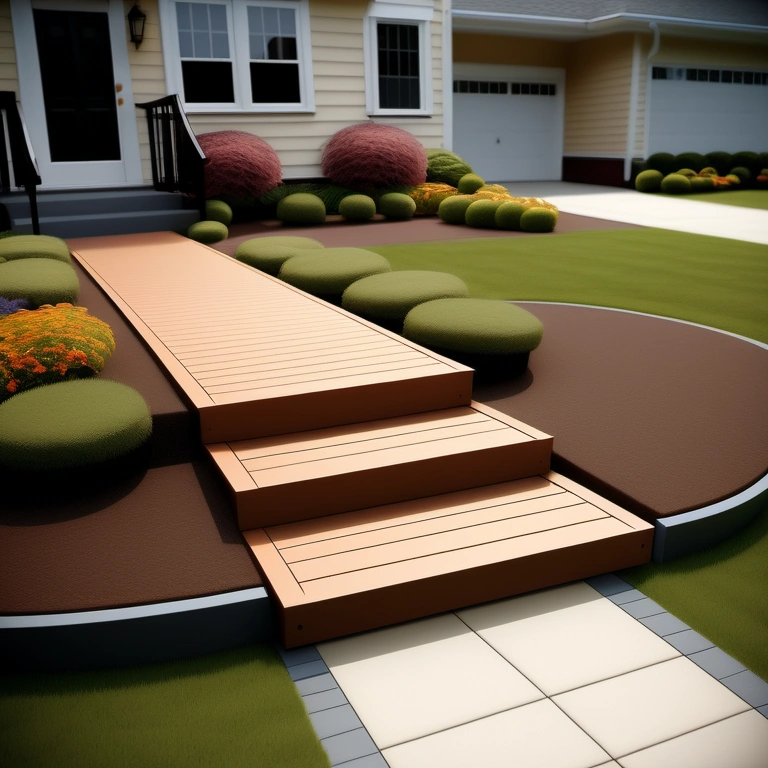Boosting Curb Appeal & Independence: Accessibility-Focused Exterior Home Modifications for Aging in Place
Introduction: Embracing Independence Through Accessible Home Design
Imagine your home, not just as a place of comfort, but as a sanctuary that empowers you or your loved ones to live independently and safely for years to come. The concept of ‘aging in place’ has gained significant traction in recent years, reflecting a desire among many to remain in their homes as they grow older. However, this often requires thoughtful accessible home modifications, particularly to the exterior of the home. These aren’t just about adding ramps; they’re about creating an environment that is both aesthetically pleasing and functionally accessible.
This guide will walk you through practical, cost-effective, and visually appealing exterior home modifications that prioritize accessibility, safety, and independence. We’ll explore everything from ramps and pathways to gardening solutions and lighting, all while keeping universal design home principles at the forefront. The goal? To help you create an exterior space that enhances curb appeal and fosters a sense of freedom and well-being. While this article focuses on innovations from the past decade (2010-2019), the principles and practices remain highly relevant today.
Embracing the concept of aging in place exterior design requires a shift in perspective, viewing home improvements as investments in long-term well-being and independence. Exterior accessibility projects, while seemingly daunting, can be strategically managed to maximize impact while minimizing costs. A well-defined project plan, encompassing everything from initial design concepts to material selection and contractor coordination, is crucial. Prioritizing modifications based on immediate needs and budget constraints is a cost-effective approach. For example, addressing hazardous walkways with non-slip walkways or installing motion sensor lighting can significantly improve safety and prevent falls, often at a lower cost than a full-scale renovation.
This proactive approach not only enhances safety but also contributes to the overall value and appeal of the property. When considering home modifications for seniors, it’s essential to integrate universal design principles. This approach focuses on creating spaces that are usable by people of all ages and abilities, ensuring that modifications are not only functional but also aesthetically pleasing and seamlessly integrated into the existing landscape. Wheelchair accessible landscaping, for example, goes beyond simply adding ramps for homes; it involves creating accessible garden design with raised garden beds, smooth, wide pathways, and comfortable seating areas.
Thoughtful planning also includes considering the slope and surface of walkways to ensure easy navigation for individuals with mobility challenges. By focusing on universal design, we can create exterior spaces that are both beautiful and accessible, promoting independence and enhancing the quality of life for everyone. Furthermore, the implementation of accessible home modifications extends beyond mere physical changes; it encompasses a holistic approach to enhancing the overall living experience. The integration of technology, such as smart home systems that control exterior lighting and security features, can provide an added layer of convenience and safety. Exploring grant programs and financial assistance options can also help offset the costs associated with these renovations. By combining thoughtful design, strategic project management, and leveraging available resources, homeowners can create exterior spaces that not only meet their accessibility needs but also enhance their quality of life and sense of independence. This proactive approach ensures that the home remains a source of comfort, security, and enjoyment for years to come.
Ramps and Sloped Walkways: Paving the Way for Easier Access
Ramps and sloped walkways are often the first and most crucial accessible home modifications for improving accessibility and facilitating aging in place exterior. They provide a smooth, gradual transition for individuals using wheelchairs, walkers, or those with mobility challenges, transforming previously insurmountable barriers into easily navigable paths. Prioritizing exterior accessibility not only enhances safety and independence but also contributes significantly to the overall quality of life for individuals with mobility limitations. Integrating ramps and sloped walkways aligns with the principles of universal design home, ensuring that the exterior environment is usable by people of all ages and abilities.
Material Options: When selecting materials for ramps and sloped walkways, consider both aesthetic appeal and functional performance. Wood offers a classic, warm aesthetic and is relatively cost-effective for ramps for homes. Pressure-treated lumber is essential for durability and resistance to rot, especially in damp climates. Concrete provides a durable and low-maintenance option, ideal for high-traffic areas, but can be more expensive upfront. Composite materials, made from recycled plastic and wood fibers, offer excellent weather resistance, require minimal upkeep, and often feature non-slip walkways, enhancing safety in wet conditions.
The choice of material should complement the existing architecture and landscaping while prioritizing safety and longevity. Building Codes and Slope Guidelines: Adhering to local building codes is paramount when undertaking home modifications for seniors. The Americans with Disabilities Act (ADA) recommends a maximum slope of 1:12 for commercial applications, meaning for every inch of rise, there should be 12 inches of run. While residential guidelines may vary, adhering to the ADA standard ensures optimal accessibility.
Handrails are typically required for ramps with a rise of more than 6 inches or a run of more than 72 inches, providing essential support and stability. Proper permitting and inspection are crucial steps in exterior renovation project management to ensure compliance and safety. Cost Considerations: The cost of a ramp varies depending on the material, length, complexity of the design, and local labor rates. A simple wooden ramp might cost between $1,000 and $3,000, representing a cost-effective exterior improvement strategy, while a concrete or composite ramp could range from $3,000 to $10,000 or more.
Consider obtaining multiple quotes from local contractors to ensure you’re getting a fair price. Exploring financing options and potential grants for home modifications can also help offset the cost of these essential improvements. Real-World Example: A homeowner in Seattle replaced their steep, uneven front steps with a gently sloped composite ramp, seamlessly blending it with the existing landscaping, showcasing wheelchair accessible landscaping principles. The ramp not only improved accessibility but also enhanced the home’s curb appeal, adding a modern touch. The project also incorporated motion sensor lighting along the ramp to enhance safety during nighttime use. Another example involves a family in Boston who installed a heated concrete ramp to prevent ice accumulation during the winter months, ensuring year-round accessibility. Such proactive home modifications exemplify a commitment to creating a safe and inclusive environment for aging in place.
Accessible Pathways and Entrances: Creating a Safe and Welcoming Approach
Creating accessible pathways and entrances is paramount in designing an aging in place exterior, extending beyond mere ramp installations to encompass the entire journey from the public right-of-way to the front door. This holistic approach ensures a safe, comfortable, and dignified experience for individuals of all abilities, reflecting the principles of universal design home modifications. Thoughtful planning in this area minimizes potential hazards and promotes independence, a cornerstone of accessible home modifications. Widening Pathways: Navigating narrow pathways can be a significant obstacle for those using mobility devices.
Adhering to accessibility standards, aim for a minimum pathway width of 36 inches, but consider 48 inches for optimal maneuverability, especially when turns are involved. The pathway’s composition is equally important; a stable, firm, and even surface is crucial. Avoid loose gravel or uneven pavers, which can pose tripping hazards. When managing an exterior renovation project, remember to factor in the existing landscape and drainage patterns to prevent water accumulation, which can exacerbate accessibility issues.
Non-Slip Surfaces: The selection of non-slip walkways is critical for safety, particularly in regions prone to wet or icy conditions. Textured concrete offers a durable and cost-effective solution, while pavers with a rough finish provide an aesthetically pleasing alternative. Rubberized coatings, though potentially more expensive, offer superior slip resistance and cushioning. When budgeting for these improvements, consider the long-term cost-effectiveness of preventing falls and injuries. Investing in high-quality, non-slip materials is a key element of cost-effective exterior improvement strategies.
Minimizing Steps: Steps present a considerable challenge for individuals with mobility limitations. When possible, eliminate steps entirely by grading the landscape to create a seamless transition. If steps are unavoidable, ensure they have a consistent rise (ideally no more than 7 inches) and a generous run (at least 11 inches). Adding handrails on both sides, extending beyond the top and bottom steps, provides additional support and stability. These seemingly small details significantly enhance exterior accessibility and contribute to a safer environment for home modifications for seniors.
Proper Lighting: Adequate lighting is essential for safe navigation, especially during nighttime hours. Install motion sensor lighting along pathways and at entrances to provide automatic illumination, deterring potential intruders and enhancing visibility. Consider incorporating low-voltage landscape lighting to highlight pathway edges and architectural features, further improving safety and aesthetics. Strategic lighting is a crucial element of wheelchair accessible landscaping and accessible garden design, creating a welcoming and secure environment. Real-World Example: In Portland, Oregon, a homeowner transformed their front entrance by replacing a steep set of stairs with a gently sloping ramp constructed of composite decking, a durable and slip-resistant material. They widened the adjacent pathway using permeable pavers, creating a smooth, non-slip surface that allows rainwater to drain effectively. Low-voltage LED lighting was integrated along the pathway and ramp, enhancing visibility and safety at night. This project exemplifies how thoughtful design and careful material selection can create an accessible and aesthetically pleasing entrance. [Link to local contractors]
Accessible Gardening Solutions: Cultivating Independence and Well-being
Gardening is a beloved pastime for many, but traditional gardening can be physically demanding. Accessible gardening solutions allow individuals with limited mobility to continue enjoying this rewarding activity. These solutions are crucial components of aging in place exterior design, fostering independence and enhancing quality of life. From a project management perspective, integrating accessible gardening features into exterior renovations requires careful planning and consideration of the homeowner’s specific needs and abilities. It’s about creating a space that is not only beautiful but also functional and safe.
Raised Garden Beds: Raised garden beds eliminate the need for bending and kneeling, making gardening more accessible and comfortable. They can be constructed from various materials, including wood, concrete blocks, or repurposed containers. When planning accessible home modifications, consider the height and depth of the beds, ensuring they are easily reachable from a seated position. The ideal height typically ranges from 24 to 36 inches. For cost-effective exterior improvement strategies, explore using reclaimed materials or DIY kits for constructing raised beds.
Remember to factor in proper drainage and soil composition to ensure successful plant growth. Accessible Tools: Ergonomically designed tools with long handles and comfortable grips can reduce strain and fatigue. Look for tools specifically designed for individuals with arthritis or limited hand strength. Investing in high-quality, durable tools is a smart move within your home modifications for seniors budget, as they will last longer and provide better support. Consider tools with cushioned grips, lightweight materials, and angled handles to minimize stress on joints.
Furthermore, tool organizers and storage solutions placed at accessible heights can prevent unnecessary reaching and bending, contributing to a safer and more enjoyable gardening experience. Ergonomic Designs: Consider incorporating ergonomic designs into your garden layout. This might include wide pathways, seating areas, and adjustable-height work surfaces. Wheelchair accessible landscaping requires careful attention to pathway widths and surface materials. Aim for pathways that are at least 36 inches wide, with a smooth, non-slip surface such as compacted gravel or pavers.
Incorporating seating areas with comfortable benches or chairs allows for rest breaks and provides a place to enjoy the garden’s beauty. Adjustable-height work surfaces, like potting benches, can be customized to individual needs, promoting proper posture and reducing strain. These elements of universal design home principles ensure the garden is usable and enjoyable for everyone, regardless of their physical abilities. Real-World Example: A community garden in Portland incorporated a series of raised garden beds of varying heights, catering to individuals with different mobility levels.
They also provided a selection of accessible tools and gardening gloves, making the garden a welcoming space for everyone. [Link to assistive technology providers] Another example is the Brooklyn Botanic Garden, which features a sensory garden designed to be accessible to individuals with visual and physical impairments. Their design incorporates tactile elements, fragrant plants, and accessible pathways, demonstrating how gardens can be inclusive and engaging for all. Such initiatives highlight the importance of considering diverse needs when planning accessible garden design and emphasize the positive impact of creating inclusive outdoor spaces. This approach aligns with the broader goals of exterior accessibility and promotes a sense of community and well-being.
Exterior Lighting and Safety Features: Ensuring Security and Peace of Mind
Exterior lighting and safety features play a vital role in creating a secure and accessible environment, particularly crucial for aging in place exterior home modifications. Thoughtful illumination not only enhances visibility but also contributes to a sense of security and independence for residents and visitors alike. For instance, strategically placed lights along non-slip walkways and near ramps for homes can significantly reduce the risk of falls, especially during nighttime hours or in inclement weather. Furthermore, well-lit entrances and accessible garden design elements ensure that individuals with mobility challenges can navigate the exterior of the home with confidence and ease.
Motion-sensor lights provide automatic illumination, deterring intruders and enhancing safety for individuals navigating the exterior of the home at night. Beyond basic security, consider the color temperature of your exterior lighting. Warmer tones (around 3000K) are generally more inviting and less harsh than cooler, blue-toned lights, which can be disorienting for some individuals. Also, ensure that light fixtures are properly shielded to minimize light pollution and glare, further enhancing visibility and comfort. These considerations are especially important when implementing accessible home modifications for seniors.
Doorbell cameras allow homeowners to see and speak to visitors remotely, providing an added layer of security and convenience. Many models now integrate with smart home systems, allowing for remote monitoring and control from smartphones or tablets. Features like two-way audio and night vision further enhance their utility, providing peace of mind and increased security. From a project management perspective, ensure proper wiring and network connectivity are planned for during the exterior renovation project to maximize the functionality of these devices.
This is a key element in universal design home planning. Emergency Call Systems: Consider installing an emergency call system that allows individuals to quickly summon help in case of a fall or other emergency. These systems can range from simple wearable pendants to more sophisticated, professionally monitored services. Location-aware technologies can pinpoint the individual’s location within the property, enabling a faster response from emergency services. When considering cost-effective exterior improvement strategies, evaluate the long-term benefits of such a system in terms of safety and peace of mind.
Universal Design Principles: Universal design aims to create products and environments that are usable by all people, to the greatest extent possible, without the need for adaptation or specialized design. Integrating accessibility seamlessly into the home’s existing architecture is key. For example, choosing door hardware that is easy to grip and operate, or selecting exterior finishes that are durable and low-maintenance. Wheelchair accessible landscaping should also be considered, ensuring that pathways and garden areas are easily navigable.
Real-World Example: A homeowner in Austin installed a smart doorbell camera and motion-sensor lights around their property, providing enhanced security and peace of mind. They also incorporated universal design principles throughout their exterior renovations, ensuring that the space was both accessible and aesthetically pleasing. The transformation included the installation of wider, gently sloped pathways, raised garden beds, and a covered porch with ample lighting. This not only enhanced the home’s curb appeal but also significantly improved its accessibility for both the homeowner and visitors. [Link to ADA guidelines]


